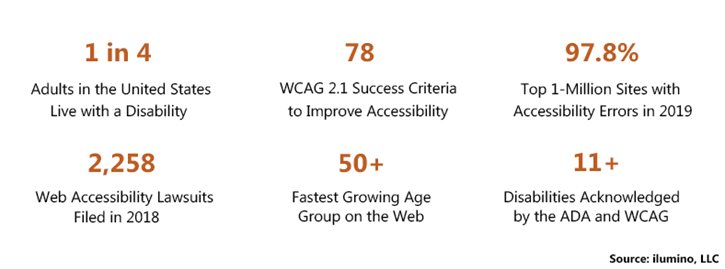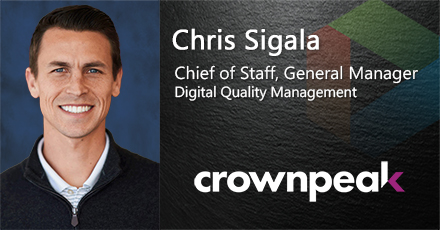A Roadmap for Improving Digital Accessibility
Across the world, more than one billion people live with a disability, which is why providing digital accessibility is not only essential; it’s the law. The World Wide Web Consortium's (W3C) Web Accessibility Initiative (WAI) provides several guidelines for accessible web development & interaction, including Web Content Accessibility Guidelines (WCAG), Authoring Tool Accessibility Guidelines (ATAG), and User Agent Accessibility Guidelines (UAAG).
In the US, standards are established and maintained by the United States Department of Justice Civil Rights Division through the Americans with Disabilities Act (ADA). There is also the United States Access Board, an independent federal agency that promotes equality for people with disabilities through leadership in accessible design and the development of accessibility guidelines and standards. Under ICT Accessibility Section 508 Standards, agencies must give disabled employees and members of the public access to information that is comparable to the access available to others.
Although plaintiffs have taken legal action against both the Social Security Administration and the Department of Homeland Security over Section 508 violations, the vast majority of federal accessibility lawsuits filed have been ADA Title III: Public Accommodations claims. With ever-increasing reliance on websites to provide information, make purchases, and engage with essential services, inaccessible digital spaces are as great a barrier as inaccessible physical spaces.

Digital Accessibility Makes Sense...How Do We Get There?
Digital accessibility is defined as the ability of a website, mobile application, or electronic document to be easily navigated and understood by a wide range of users, including those who have visual, auditory, motor, or cognitive disabilities. Improving website accessibility is not solely for those with disabilities but those that may have limited bandwidth as well. If you’re at the planning stage of launching a website, it’s important to include digital experiences that are inclusive of all users. That’s a goal most organizations can agree on, but as for getting there, it’s a different story. Challenges related to cost, complexity, and knowledge gaps often hold companies back.
On April 29, 2021, Crownpeak and ilumino, a digital accessibility service and consulting firm, announced a strategic partnership that would enable companies to accelerate digital accessibility goals and simplify the formation and execution of best-in-class digital governance programs. In layman's terms — a no-nonsense approach to accessibility for your website in a user-friendly and digitally compliant manner.
“All too often, when it comes to accessibility testing, companies receive ‘one-and-done’ reports on violations with no real consideration of the company’s technical resources or its ability to actually act on the findings,” said Mark Reardon, CEO at ilumino. “So benefits achieved are often just temporary. Crownpeak + ilumino offers a better solution and, importantly, a path toward continual compliance. Our partnership combines the scalability of Crownpeak's software platform with our expert manual consulting services. Together, we offer organizations a global solution for their digital monitoring and compliance needs – all within the unique confines of their established branding and marketing, and all aimed at providing more inclusive digital experiences,” states Mark.
To better understand how companies can look to simplify and accelerate their digital accessibility goals, I had the opportunity to interview Chris Sigala, Chief of Staff and General Manager, Digital Quality Management at Crownpeak.
Interviewee: Chris Sigala, Chief of Staff and General Manager, Digital Quality Management 
Would you please explain the importance of digital accessibility?
"Digital accessibility. Think of it as delivering fully accessible digital experiences. Your digital presence — that’s anything from websites, mobile apps, connected devices, software applications — can all be accessed by individuals living with all forms of disabilities.
"Why is it important that digital experiences be available and accessible to all people? First and foremost, it’s just the right thing to do. The unfortunate reality for organizations offering a digital service in a manner that is not equal to all people is that they're conducting a form of implicit discrimination, even if it’s not intentional. There’s an assortment of global laws out there that are aimed at addressing this discrimination element for individuals living with disabilities. There is the Accessible Canada Act (ACA), the EU’s Web Accessibility Directive, and back in 1990, George W. Bush put into law the Americans with Disability Act (ADA) to prohibit discrimination against individuals with disabilities in all areas of public life. Looking at data over the last five years, we’ve seen a significant increase in the number of lawsuits that have been filed, specifically under Title III of the ADA, focused around websites. A notable case — one in which a blind user sued Domino’s Pizza for an inability to access ordering pizza online and on their mobile app — gained a lot of press and notoriety pertinent to web accessibility, with websites being considered a public place of accommodation. The growing volume of lawsuits in this space is driving more acute awareness around the legal risk associated with operating an accessible website.
"It’s also thinking about web accessibility from a business value and ROI perspective. When we speak to clients about their goals and objectives around addressing digital accessibility, we find companies are addressing web accessibility because they see an opportunity to expand markets and elevate their brand by better serving the people with disabilities. There’s a one-to-one correlation between engagement on a site and other metrics, including conversion rates, bounce rates, and optimized engagement on the site. A survey conducted of folks who live with disabilities asked what the likelihood was of them leaving a website that wasn’t accessible. The response was an overwhelming 71% of respondents said they would immediately leave a website if they determined it wasn’t accessible to their needs. Couple that with the fact that, in the US alone, individuals that are living with disabilities account for a significant amount of GDP — most estimates are around half a trillion dollars. It represents a market segment that companies are missing by not incorporating inclusive experiences online and through digital channels to meet the needs of those potential customers.
"Given the context of the current environment we’re living in — the pandemic, the rising awareness of social issues, and social movements — the importance of equity and inclusion are driving an overall awareness of the digital accessibility issue. It’s a core requirement to address the digital channels that have become so important to the continuity of business."
What are some examples of web accessibility issues?
"Assistive technology, such as screen readers or navigating websites with only a keyboard and other tools & technologies, needs to correctly identify the elements of a site to provide an equal engagement experience for all users. There are a couple of common issues as they relate to ensuring a site can be leveraged with screen readers, such as areas of websites and aspects of websites that lack the proper meta descriptions, the proper labeling, or the proper structure and hierarchical elements that enable assistive technologies to effectively engage with the site. An example of this includes images on a website that don’t have the proper alt-text associated with them. In those sorts of cases, a screen reader isn’t able to identify what that image or its intended use is on the site, and therefore, the end-user is missing an opportunity to engage with that site in an equitable way. Similarly with links or forms; it’s common that there are missing meta tags — text associated with text or labels associated with what those elements are — that speak to or interact with the screen reader to identify what the element is and what it does and will read back the intended uses of that element to the user.
"The way I think about accessibility on websites and digital channels is this idea of providing a like-for-like experience between a non-disabled person engaging with a website and a person living with a disability that may be leveraging assistive technology to engage with that website. The crux is ensuring the website, or any digital touchpoint from a foundational source code perspective, can be accurately analyzed and processed by assistive technology, so the end experience for that user is the same and equitable — regardless of abilities."
Although the industry has taken the matter of digital accessibility more seriously, why do you think some companies are still not providing accessibility or improving their website accessibility?
"Crownpeak has been in the market for a long time, and we’ve had the benefit of working with some of the largest and most recognizable brands in the world that have been spending a lot of time and effort to address these issues. But to your point, it hasn’t been widely adopted. And I think there are a number of various challenges or barriers for organizations that are attempting to achieve more accessible websites. Those challenges can be broken down into a few different areas, but we like to think of them in the context of the overall maturity of the organization as it relates to an accessibility program or an accessibility journey.
"On one end of the spectrum, you have companies that are just starting their accessibility journey. Oftentimes, the challenge is achieving an organizational-wide buy-in and having the proper executive alignment on addressing the problems, to begin with. That’s where those elements we originally spoke about around why is this important comes into play — things like risk mitigation. The legal risk element is a significant driver in terms of achieving more alignment and buy-in from executives and across the organization. And elevating brand — achieving or optimizing revenue opportunities that come with better serving people with disabilities. All of those things boiled together allow companies to start to build a business case and an ROI around embarking on the accessibility program that we’re focused on delivering.
"And then you have companies that have already started on a journey. Think of it as they’re tiptoeing their way into testing and kind of building out what a program would look like. With these companies, the challenge for them is establishing a scalable, repeatable process and general approach to how they’re going about addressing this problem. Many of these organizations are using some combination of manual reviews by in-house teams that likely aren’t very well-versed in the accessibility guidelines. They also may be using free or a really low-cost kind of page checking tools — browser check plugins that allow a user to run a scan on a singular page to identify accessibility issues — that will identify issues, but the problem becomes replicating that across several websites and thousands of pages across disparate teams in different business units. It just doesn’t scale to the needs of a wider organization.
"The last challenge is about costs and resources. Oftentimes, companies are seeking to retrofit an existing website to be fully compliant, but they find that overhauling the existing website is cost-prohibitive — it’s going to take way too long, be way too costly, and it’s just not worth the effort in their mind. That’s where expert consulting guidance comes in. It’s important to look at an organization holistically from a digital estate perspective and develop a program that best fits the needs of that organization, their specific requirements and needs, and the resources available. It can be a blended approach of retrofitting certain elements of certain sites where there’s more priority or focus while also bringing accessibility further into the development process so that accessibility issues aren’t presented in new content that’s being published."
Organizations understand the importance of improving the accessibility of their websites, but they have no idea where to start. How do companies create a roadmap for improving their website accessibility?
"We hear from businesses all the time that they know why it’s important, they would love to do something to address it, but it’s such a complex and nuanced issue; where and how do they start? For us, it all starts with getting a firm grasp on the current state of an organization’s digital presence. What does the total scope of issues look like? Hundreds of issues? Thousands of issues? Hundreds of thousands of issues? Where do those issues exist, and what is the extent of the issues? Once that that evaluation is done, an organization can properly size the project and consider the resources and organizational processes that will need to be implemented to execute the goal.
"Crownpeak’s automated scanning tool — known as Digital Quality Management (DQM) — can be really powerful in that initial assessment. DQM will scan in a company’s entire digital estate, and in a matter of hours, identify the presence of all of the accessibility issues, from an automated perspective, on those websites (such as no descriptions or context) and how they relate back to Web Content Accessibility Guidelines (WCAG).
"That’s where a two-pronged approach comes into play around this inventory of issues from an automated perspective. The reality in today’s marketplace is that no automated tool can identify 100% of the WCAG success criteria, and it’s common knowledge in this space that 75% of WCAG success criteria require manual testing and expert guidance. So, after the DQM scan, should a company also then augment the scan with a manual audit of its current standing to understand the full comprehensive scope of the issues that exist on the website? Then, go about a program of addressing those issues, both from an automated and manual perspective? It’s a more ambitious approach to how you would tackle it, step-by-step, removing issues. The other would be to focus on just the automated platform, the issues that are presented there-in, and remove those issues first before then layering on manual testing and consulting above that."
Final Thoughts
It’s clear to me that the Crownpeak and ilumino partnership is heading in the right direction in providing a valuable service for enterprise-level organizations looking to achieve digital accessibility and compliance with their website properties. What’s not clear at this point in time is when a cultural adoption of accessibility and compliance will filter down to the small and medium-sized business websites. With over 97% of the top one million sites having found accessibility errors, we still have a long way to go in fully supporting those with disabilities.

Gary Eisenstein
Gary has been working in the IT industry since 1993 and is the Principal Analyst at CMS-Connected, and the Founder and President of Falcon-Software. If you would like advice on how to evaluate a "best-fit" digital experience solution for your organization, Gary can be reached at gary.eisenstein@cms-connected.com.